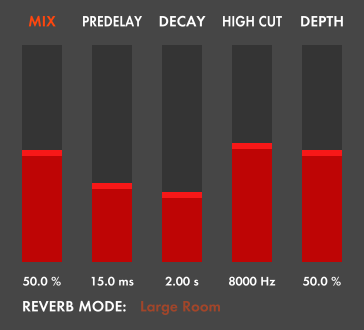Subtotal: $50 USD
ValhallaRoom: The High Level Sliders
The ValhallaRoom GUI is divided into several sections. The sliders in the left part of the GUI represent the high level parameters, in that they have the most dramatic and immediate effects on the sound.
From left to right, the parameters are:
- MIX: The mix slider controls the balance of the dry input signal to the “wet” reverberated signal, expressed as a percentage. 0% represents a fully dry signal, 100% is fully wet. The Mix slider uses a sine/cosine crossfade, such that the signal is balanced in volume at all settings of Mix.
- PREDELAY: The standard predelay control, which delays the onset of the Early and Late reverberation. The delay time is expressed in milliseconds. Predelay is useful in establishing the “size” of the room, in that the first reflections won’t be heard until after the predelay time. It can be viewed as moving the “walls” of the space in and out. From a non-physical perspective, the Predelay control is used to add some “space” between the input signal and the onset of the reverb decay, which can add clarity to the source signal. In the olden days, tape echos were used to add 15 to 30 milliseconds of predelay to the input of a reverberation chamber or plate.
- DECAY: The high level decay control for the Late reverberation. The Decay control could also be labeled “RT60” which stands for the time (T) needed for the reverb (R) to decay to a level 1/1oooth of the initial level (-60 dB). The decay time is based on the mid frequencies – the Bass Mult and High Mult controls in the Late section are used to dial in the decay times at low and high frequencies, which will be explained in more detail later.
- HIGH CUT: Controls the cutoff frequency of a -12dB/oct lowpass filter, with the units measured in Hertz. The relatively steep slope of this filter creates a more “natural” sound in the high frequencies, which reflects the air and wall absorption found in real acoustic spaces. Setting this to a range between 3000 and 7500 Hz is optimal for most larger rooms, while higher settings of High Cut are useful for emulating chambers and plates, as well as the brighter sounds of many digital reverberators.
- DEPTH: Controls the balance between the Early and Late reverb sections, measured as a percentage. 0% represents a signal that is only from the Early Reverb, while 100% represents a signal that is all Late reverb. The Depth control uses a sine/cosine crossfade. In addition, a great deal of effort went into “normalizing” the levels of the Early and Late reverb sections, such that the output levels are balanced over virtually the whole Decay range. This control was called “Depth” as a tribute to some of the classic digital reverberators such as the Lexicon 224 and Eventide SP2016, which featured Depth controls that adjusted the balance between early and late reverberation. The effect simulates moving a microphone further away from the source, or (more accurately) controlling the mix between close mikes and room mikes. The Depth control could have been called the “Early/Late Mix” control, but I didn’t like how that looked in the UI.
In addition to the high level sliders, the left part of the GUI contains the Reverb Mode selector, which will be the subject of the next blog post.
 Valhalla UberMod
Valhalla UberMod 




Pleased to find this tips-and-tricks section on your website. I’ve owned VahallaRoom for some time. I love the sounds, but also I felt like I wasn’t getting exactly what I wanted out of it. After a few months playing with it, I loaded up some other reverbs , ones I used to always default to, which helped me decide Vahalla has more potential than the others however I may not be tapping into it correctly. So I came back to your site looking for documentation.
I think we open a plugin and are influenced by names of presets and names given to dials and parameters, but those names are often just arbitrary words that have different meanings to different people–different meanings to the developer and a user. We read a name of a preset and it influences our ears, instead of listening carefully in a blind test. But I feel like some of this info in tips-and-tricks gives me a better understanding of the rooms and algorithms so maybe now I can make better use of the controls in Room.
Thanks for your dedication and making this tool available at such a great price. Lots of hard hard labor in software development, not to mention design and writing of follow up documentation.
Sean: My comment above really applies more to your blog post on the 4 Basic Reverb Modes. I read several of the tips-and-tricks posts (out of order to how you posted them) and then commented.
What is the MIX lock function supposed to do? It greys out but doesn’t seem to affect the sound or functionality, but I may have missed something..
The MIX Lock will lock the slider when changing presets. In other words, YOU can still change the Mix value via the slider or automation when it is locked, but the Mix setting will be preserved when browsing between the presets.
Ah right, that’s really handy! Thanks for getting back to me.